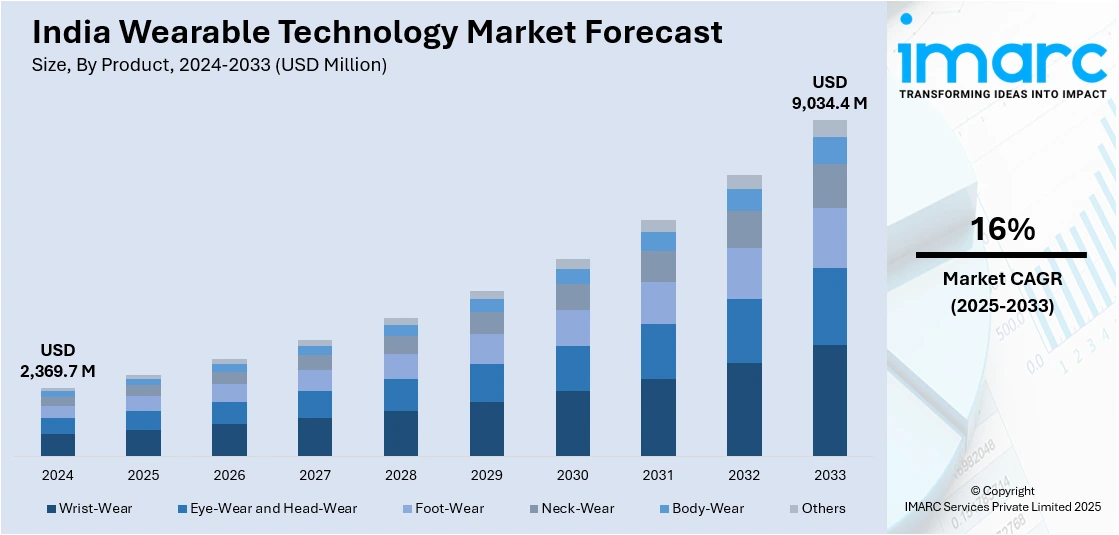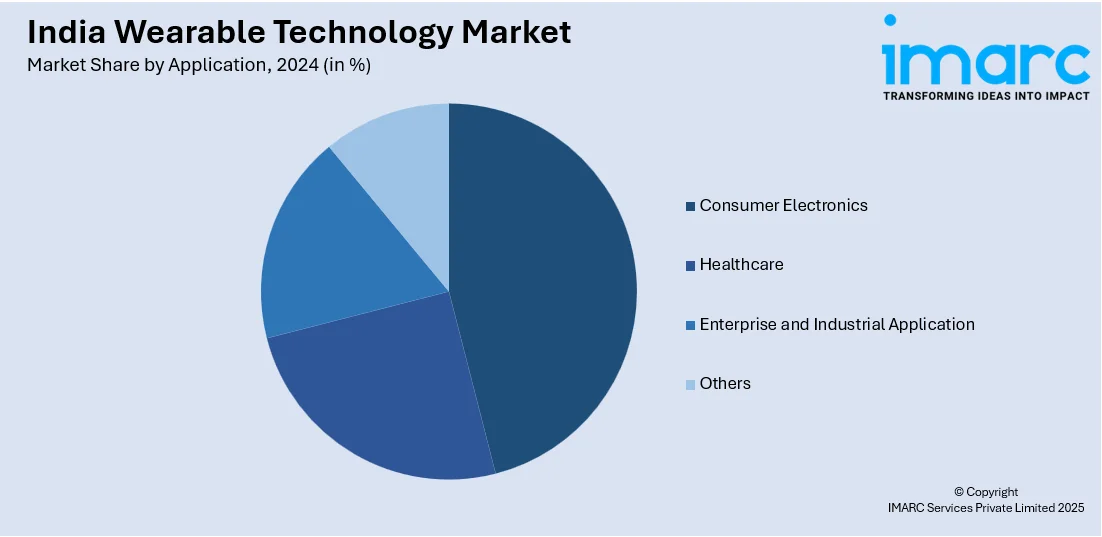
India Wearable Technology Market Size, Share, Trends and Forecast by Product, Application, and Region, 2025-2033
Market Overview:
The India wearable technology market size reached USD 2,369.7 Million in 2024. The market is projected to reach USD 9,034.4 Million by 2033, exhibiting a growth rate (CAGR) of 16% during 2025-2033. Market growth is driven by increasing disposable income levels of the consumers, rising health awareness, particularly among the millennials and Gen Z population, and the growing adoption of smart and connected devices.
Market Insights:
- Regional segmentation includes North India, West and Central India, South India, and East and Northeast India.
- The market is segmented by product, including wrist-wear, eye-wear and head-wear, foot-wear, neck-wear, body-wear, and others.
- Based on application, the market includes consumer electronics, healthcare, and enterprise and industrial applications.
Market Size and Forecast:
- 2024 Market Size: USD 2,369.7 Million
- 2033 Projected Market Size: USD 9,034.4 Million
- CAGR (2025–2033): 16%
Wearable technology represents a sophisticated technological innovation incorporated into electronic devices or gadgets designed to be conveniently worn on the body for the real-time monitoring of biometric information. These devices may be seamlessly integrated into clothing or even implanted within the user's body. Commonly utilized wearable technology devices encompass smartwatches, head-mounted displays, smart jewelry, implantable devices, and fitness trackers. These gadgets facilitate the wearer in monitoring metrics such as pulse rate, heart rate, steps taken, and sleep duration. Distinguished by their hands-free nature, wearable technology devices employ microprocessors and sensors to receive and instantly track information, offering a seamless and efficient user experience.
The wearable technology market share in India is undergoing significant expansion, driven by a combination of technological advancements, increasing health consciousness, and a growing affinity for smart and connected devices. Key devices in the Indian wearable technology market include smartwatches, head-mounted displays, smart jewelry, implantable devices, and fitness trackers. Moreover, these devices offer users the ability to monitor essential health metrics such as pulse rate, heart rate, steps taken, and sleep patterns. Besides this, the integration of wearable technology into everyday life is particularly evident in the fitness and wellness sector, where individuals seek hands-free solutions for health monitoring and lifestyle enhancement, further augmenting the India wearable technology market share. In addition to health and fitness applications, wearable technology is making inroads into various industries, including entertainment, communication, and enterprise. Enterprises are exploring the use of wearable technology for employee wellness programs and improved productivity. Furthermore, the hands-free and real-time tracking capabilities of wearable devices, driven by microprocessors and sensors, resonate well with the digitally savvy population in India. Apart from this, government initiatives promoting digital adoption and the evolving consumer lifestyle contribute to the optimistic outlook for the wearable technology industry in India. With ongoing innovations and a diverse range of applications, wearable technology is becoming an integral part of the Indian consumer's daily life, which is expected to fuel the market growth in the coming years.

To get more information of this market, Request Sample
India Wearable Technology Market Trends:
Shifts in Consumer Behavior and Multifunctional Wearables
The growing consumer demand for multifunctional and stylish wearables is reshaping the wearable technology market size in India. As consumers search more and more for products that seamlessly integrate into their lives, attention has moved from simple fitness trackers to more advanced, all-inclusive devices. Smart clothing, for example, is gaining traction with fashion and functionality being merged to enable users to track health indicators without sacrificing style. Likewise, smart jewelry and smart glasses are increasingly popular as more visually appealing wearables. Besides adding more health monitoring capabilities, these products also provide other features such as augmented reality (AR), making user experiences in entertainment and business environments better, hence supporting the India wearable technology market growth. As consumers become increasingly technologically savvy, they now expect wearables that are not only health-focused but also seamlessly blend into their online world, offering increased connectivity, productivity, and entertainment capabilities. This growing trend has resulted in innovations that focus on finding an optimal balance between functionality and aesthetics. Businesses are concentrating on providing niche wearables that cater to the unique requirements of various customer groups, ranging from sports enthusiasts to medical professionals to consumers looking for sophisticated health-monitoring products.
Integration with Healthcare and the Impact of Urbanization
The integration of wearable technology with healthcare is leading intense innovation in the industry. Individuals are now on the lookout for converged solutions that offer whole health intelligence and constant monitoring. The convergence of wearable technology with healthcare is creating tremendous innovation within the industry. Smart devices like smartwatches and fitness trackers are increasingly being used to monitor ongoing conditions, monitor vital signs, and monitor overall health of a person better, which is enhancing the India wearable technology market share. This is especially relevant as the healthcare industry is under greater pressure to make care solutions accessible, personalized, and efficient. In India, for instance, with growing health issues like diabetes, cardiovascular diseases, and mental health increasing in prevalence, wearables are a solution to monitor patients continuously while remotely accessing them, lowering hospital visits and enhancing overall health care management. Urbanization also contributes to wearables' adoption, since residents of urban areas, who have higher disposable incomes and are more likely to adopt a digitally connected lifestyle, are more likely to spend on these devices, according to India wearable technology market analysis.
India Wearable Technology Market Segmentation:
IMARC Group provides an analysis of the key trends in each segment of the market, along with forecasts at the country level for 2025-2033. Our report has categorized the market based on product and application.
Product Insights:
- Wrist-Wear
- Eye-Wear and Head-Wear
- Foot-Wear
- Neck-Wear
- Body-Wear
- Others
The report has provided a detailed breakup and analysis of the market based on the product. This includes wrist-wear, eye-wear and head-wear, foot-wear, neck-wear, body-wear, and others.
Application Insights:

- Consumer Electronics
- Healthcare
- Enterprise and Industrial Application
- Others
A detailed breakup and analysis of the market based on the application have also been provided in the report. This includes consumer electronics, healthcare, enterprise and industrial application, and others.
Regional Insights:
- North India
- West and Central India
- South India
- East and Northeast India
The report has also provided a comprehensive analysis of all the major regional markets, which include North India, West and Central India, South India, and East and Northeast India.
Competitive Landscape:
The market research report has also provided a comprehensive analysis of the competitive landscape in the market. Competitive analysis such as market structure, key player positioning, top winning strategies, competitive dashboard, and company evaluation quadrant has been covered in the report. Also, detailed profiles of all major companies have been provided.
Latest News and Developments:
- In July 2025, Pebble, in collaboration with Flipkart, launched the Pebble HALO Smart Ring, India’s first smart ring featuring a digital display and gesture controls. The ring displays real-time health data (heart rate, steps, battery) directly on the ring, marking a homegrown innovation in smart wearables beyond watches and bands.
- In June 2025, JBL released the Endurance Zone open-ear sports earphones in India, featuring a flexible ear hook, IP68 durability, and up to 32 hours of battery life. These new-generation earphones are tailored for sports and active users, supporting Bluetooth 5.3 and multipoint connectivity.
- In October 2024, Samsung Electronics launched the Galaxy Ring in India, offering premium health monitoring and wellness features, including advanced sleep tracking, heart-rate sensing, and stress analysis. The device, priced from INR 38,999, positions India as an early market for Samsung's newest wearable technology.
- On September 24, 2024, WHOOP, a global leader in health and fitness wearables, officially launched its advanced wearable band in India. Targeting athletes and wellness-conscious users, the WHOOP device provides real-time tracking of recovery, strain, sleep, and stress using AI and continuous biometrics. The wearable was made available on leading Indian e-commerce platforms.
India Wearable Technology Market Report Coverage:
| Report Features | Details |
|---|---|
| Base Year of the Analysis | 2024 |
| Historical Period | 2019-2024 |
| Forecast Period | 2025-2033 |
| Units | Million USD |
| Scope of the Report | Exploration of Historical Trends and Market Outlook, Industry Catalysts and Challenges, Segment-Wise Historical and Future Market Assessment:
|
| Products Covered | Wrist-Wear, Eye-Wear and Head-Wear, Foot-Wear, Neck-Wear, Body-Wear, Others |
| Applications Covered | Consumer Electronics, Healthcare, Enterprise and Industrial Application, Others |
| Regions Covered | North India, West and Central India, South India, East and Northeast India |
| Customization Scope | 10% Free Customization |
| Post-Sale Analyst Support | 10-12 Weeks |
| Delivery Format | PDF and Excel through Email (We can also provide the editable version of the report in PPT/Word format on special request) |
Key Benefits for Stakeholders:
- IMARC’s industry report offers a comprehensive quantitative analysis of various market segments, historical and current market trends, market forecasts, and dynamics of the India wearable technology market from 2019-2033.
- The research report provides the latest information on the market drivers, challenges, and opportunities in the India wearable technology market.
- Porter's five forces analysis assist stakeholders in assessing the impact of new entrants, competitive rivalry, supplier power, buyer power, and the threat of substitution. It helps stakeholders to analyze the level of competition within the India wearable technology industry and its attractiveness.
- Competitive landscape allows stakeholders to understand their competitive environment and provides an insight into the current positions of key players in the market.
Key Questions Answered in This Report
The India wearable technology market was valued at USD 2,369.7 Million in 2024.
The India wearable technology market is projected to exhibit a CAGR of 16% during 2025-2033, reaching a value of USD 9,034.4 Million by 2033.
India's wearable technology market is driven by rising health consciousness, growing tech adoption, and lifestyle shifts among young consumers. Increased use of smartphones, improved device features, and fashion-forward designs enhance appeal. Supportive government initiatives and easy online availability further encourage usage across fitness, communication, and everyday convenience needs.
Need more help?
- Speak to our experienced analysts for insights on the current market scenarios.
- Include additional segments and countries to customize the report as per your requirement.
- Gain an unparalleled competitive advantage in your domain by understanding how to utilize the report and positively impacting your operations and revenue.
- For further assistance, please connect with our analysts.
 Request Customization
Request Customization
 Speak to an Analyst
Speak to an Analyst
 Request Brochure
Request Brochure
 Inquire Before Buying
Inquire Before Buying




.webp)




.webp)












